How To Winterize A Motorhome
When Fall Is In The Air?
Fall is the time to prepare our various Class C Motorhomes for the potential coming freeze. In many parts of the country, a severe cold season is the norm. Although some people can put their rigs into covered storage, not everyone has this option. Therefore, maybe it's time to discuss this seasonal issue just a bit.

The biggest threat, or problem, facing Class C Motorhome owners during the cold winter season is when the temperature goes below freezing inside the unit. This may cause your your standing water in the various pipes and tanks to freeze.
This frozen water will expand and can cause damage to pipes, valves, tanks, etc. In fact, this is the big reason that folks spend the time and dollars to winterize their rigs for extreme cold weather every year.
Oh, by the way, we do have cold weather in California... just not everywhere or all at once. Most of us have to go look for it. In fact, just east of beautiful Truckee, CA, there is small settlement town called Boca. In 1937 this area set a cold weather record for -45 degrees F. You can bet that they get their rigs ready for the cold season up there... either that, or they go to Arizona!
That area is East of where the Donner Party got stuck on the eastern side of the Sierra Nevada Mountains back in 1846. The Donner Party got caught by a huge storm just at the end of October, and they ended up having an incredibly tough winter.
From what I've read... if they had just had one or two more days of good weather, they would have got over the summit and been home free. As I remember, they got to within less than a quarter of a mile and had to turn around and attempt to weather it out at what is now called Donner Lake.
And Valves From Becoming Frozen
There are essentially three ways to winterize
- As I mentioned above, you can put your rig into a warm garage.
- Putting your rig in a warm garage is going to be the simplest solution... if you have a garage, or storage area.
- Putting your rig in a warm garage is going to be the simplest solution... if you have a garage, or storage area.
- Use a specially formulated pink non-toxic RV/Marine Antifreeze
to replace the existing water in your system.
- Using the non toxic antifreeze can be a good solution. You just need to make sure that the stuff gets everywhere, or something is going to pop and you will find a leak next spring when go are getting ready for your first trip. You will probably want to put a hot water Quick Turn Permanent Water Heater Bypass kit
in place so you will not have to fill up your hot water tank with expensive anti-freeze.
- Using the non toxic antifreeze can be a good solution. You just need to make sure that the stuff gets everywhere, or something is going to pop and you will find a leak next spring when go are getting ready for your first trip. You will probably want to put a hot water Quick Turn Permanent Water Heater Bypass kit
- Remove ALL of the water from your rig.
- Removing all the water can be done by using a "low point drain". Somewhere on your rig, there should be a valve that will let you drain most of the water out of the vehicle.
- On my unit, I have a spigot on the side that allows me to drain everything except the water heater. I have to drain this separately.
- On my unit, I have a spigot on the side that allows me to drain everything except the water heater. I have to drain this separately.
- The thing is, though, after letting gravity do its thing and you think all the water has been removed, you will still have pockets of the stuff here and there located throughout the system.
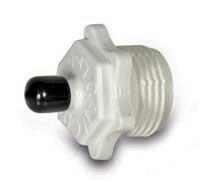
Blow-Out-Plug
- Therefore, if you want to fully winterize your rig, you will need to force this small amount of remaining water completely out. This is done by using an air compressor with an air hose connected to a Blow-Out-Plug. Install this plug to you "city water" connection... the one you normally hook your white hose to.
- Using this system, you can literally blow the water out of your Class C Motorhome. All you need is a Blow-out Plug
and enough compressed air to do the job.
- Removing all the water can be done by using a "low point drain". Somewhere on your rig, there should be a valve that will let you drain most of the water out of the vehicle.
So, is the "best" way to winterize simply getting the water out of your rig? If you have a big enough compressor to blow things out, that is going to give you the least amount of hassle. However, another alternative to accomplish this winterizing process is, if you want to keep it simple, just pour a couple of gallons of anti-freeze into your fresh water holding tank and use the rig's water pump to replace all of your existing water.
It is simple enough, just make sure that you start with the faucet that is located at the furthermost point away from your water tank. Open the spigot and wait for the pink fluid to appear. Do this with each faucet and the toilet, and you should be good to go. Don't forget to isolate your water heater so you will not fill it up with expensive anti-freeze.
If you haven't already done so, go out and buy Bob Livingston's RV Repair & Maintenance Manual. If you own a Class C Motorhome and you do not own this book, you are shooting yourself in the foot.
While you are winterizing, it doesn't hurt to rinse your fresh water system out with a water and bleach solution... you want to keep the bacteria under control.
Most of us are running around with a 35 gallon fresh water tank. The thing to do is to put around 1/4 of a cup of household bleach in this fresh water tank. Fill the tank and turn on your spigots... be sure to fill your hot water tank. When you smell the bleach, turn everything off and let it set overnight.
The next day, drain everything into your gray and black-water tanks. Be sure to flush everything out well. When you no longer smell the bleach solution, it should be good enough.
The trick here is to do a good flush with lots of fresh water. I'm getting a bit ahead of myself here. This would be something you would do early in the Spring... not when you going winterize everything. However, no mater what time of year it is doing this once a year normally keeps everything in balance.
Can Cause A Problem
There is anther way of getting a batch of bad tasting water. Sometimes if we leave our white fresh water hose exposed to the sun, the uv and the sun's radiant heat can cause water to taste stale. Keeping this hose in the shade is your best solution. However, this isn't always possible.
If you are currently using the white hose you can keep your water fresh tasting good by putting a water noodle over the sections of hose that comes in direct contact with the sun. A Camco Evo Premium Water Filter
You can buy these water noodles online for less than $10.00... or you can wait until next spring and find one at WalMart. They will be in their swimming supply section.

Return To Top Of Page
Leave We May Need To Winterize Our Plumbing In The Fall And Return To RV Maintenance: Now That You Have Been Using Your Class C Motorhome...
Leave We May Need To Winterize Our Plumbing In The Fall And Return To The Class C Motorhome: How To Achieve The Maximum RV Lifestyle! Page
YOUR STORIES
1995 Tioga Montara
Had a Leak - Ouch!
A Simple Way To Put An Electrical Thermostat On A Small Space Heater
In A Truck Camper!
A Great Destinaton, With An Unexpected Outcome!
Test Link
Below: For An Alternative Destination... A Four Mile Hike Around Sugar Pine Reservoir
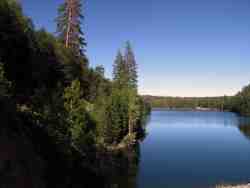
A Good Place To Begin The Joshua M. Hardt Memorial Trail Is At The Dam. This 3.5 Mile Trail Is Good For Foot Traffic And Bicycles... No Motorized stuff
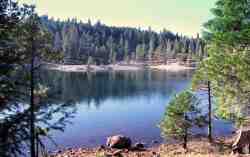
The Manzanita Day Use Area Is A Good Place To Sit And Watch The Wind
Play With The Water!
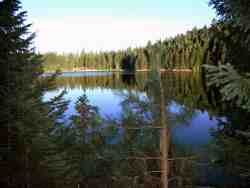
Another View From The Joshua M. Hardt Memorial Trail... Morning and Evening Are The Best Times To Hike This Trail. The Still Reflections Will Capture Your Attention
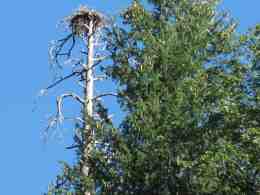
You May Want To Bring A Camera... There Are Large Birds Of Prey High In The Ski





